SN1 Study guides, Class notes & Summaries
Looking for the best study guides, study notes and summaries about SN1? On this page you'll find 190 study documents about SN1.
Page 4 out of 190 results
Sort by
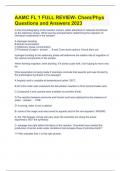
-
AAMC FL 1 FULL REVIEW- Chem/Phys Questions and Answers 2023
- Exam (elaborations) • 17 pages • 2023
-
Available in package deal
-
- $22.49
- + learn more
AAMC FL 1 FULL REVIEW- Chem/Phys Questions and Answers 2023 In the chromatography of the reaction mixture, water absorbed on cellulose functioned as the stationary phase. What was the principal factor determining the migration of individual components in the sample? A.Hydrogen bonding B.Solute concentration C.Stationary phase concentration D.Thickness of paper B and D are dumb options. Knock them out. hydrogen bonding to the stationary phase will determine the relative rate of migrati...
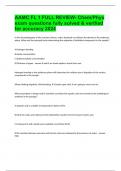
-
AAMC FL 1 FULL REVIEW- Chem/Phys exam questions fully solved & verified for accuracy 2024
- Exam (elaborations) • 24 pages • 2024
- Available in package deal
-
- $14.99
- + learn more
In the chromatography of the reaction mixture, water absorbed on cellulose functioned as the stationary phase. What was the principal factor determining the migration of individual components in the sample? A.Hydrogen bonding B.Solute concentration C.Stationary phase concentration D.Thickness of paper B and D are dumb options. Knock them out. hydrogen bonding to the stationary phase will determine the relative rate of migration of the various components in the sample. When thinking ...
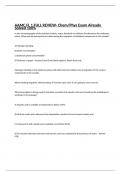
-
AAMC FL 1 FULL REVIEW- Chem/Phys Exam Already Solved 100%
- Exam (elaborations) • 25 pages • 2023
-
- $15.99
- + learn more
In the chromatography of the reaction mixture, water absorbed on cellulose functioned as the stationary phase. What was the principal factor determining the migration of individual components in the sample? A.Hydrogen bonding B.Solute concentration C.Stationary phase concentration D.Thickness of paper - Answer B and D are dumb options. Knock them out. hydrogen bonding to the stationary phase will determine the relative rate of migration of the various components in the sample. When...
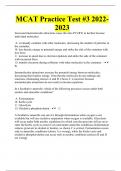
-
MCAT Practice Test #3 2022-2023
- Exam (elaborations) • 35 pages • 2023
-
Available in package deal
-
- $11.99
- + learn more
Increased intermolecular attractions cause the ratio PV/(RT) to decline because individual molecules: A. eventually combine with other molecules, decreasing the number of particles in the container. B. lose kinetic energy to potential energy and strike the side of the container with less force. C. increase in speed due to electron repulsion and strike the side of the container with increased force. D. transfer electrons during collisions with other molecules in the container. - B. ...
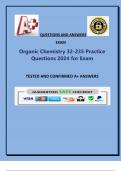
-
Organic Chemistry 32-235 Practice Questions 2024 for Exam
- Exam (elaborations) • 10 pages • 2024
-
- $10.49
- + learn more
1. The correct IUPAC name for the following compound is: (A) (1R, 3R)-1-chloro-3-methylcyclohexane H CH3 (B) (1R, 3S)-1-chloro-3-methylcyclohexane (C) (1S, 3S)-1-chloro-3-methylcyclohexane (D) (1S, 3R)-1-chloro-3-methylcyclohexane (E) None of the above. Cl H The Key here is to determine the configuration R or S for each chiral carbon. The answer here is 1S, 2S. 2. Consider the SN1 reaction of tert-butyl chloride with iodide ion: (CH3)3C Cl + I (CH3)3C I + Cl If the concentration of io...
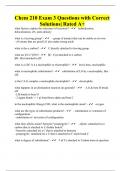
-
Chem 210 Exam 3 Questions with Correct Solutions| Rated A+
- Exam (elaborations) • 9 pages • 2023
-
Available in package deal
-
- $10.99
- + learn more
what factors explain the outcomes of reactions? - hybridization, delocalization, eN, atom density what is a leaving group? - - group of atom(s) that can be stable on its own - eN atoms that are good LG also make strong acids what is the α carbon? - C directly attached to leaving group what are β Cs? β Hs? - βC: C(s) attached to α carbon βH: H(s) attached to βC what is a LB? is it a nucleophile or electrophile? - lewis base, nucleophile what is nucleophilic ...
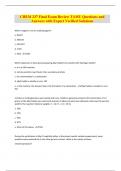
-
CHEM 237 Final Exam Review TAMU Questions and Answers with Expert Verified Solutions
- Exam (elaborations) • 29 pages • 2024
- Available in package deal
-
- $8.49
- + learn more
Which reagent is not an oxidizing agent? a. NaOCl b. KMnO4 c. K2Cr2O7 d. CrO3 e. H2O - H2O Which statement is false about preparing alkyl halide from alcohol with hydrogen halide? a. it is an SN1 reaction b. tertiary alcohols react faster than secondary alcohols c. the intermediate is a carbocation d. alkyl halide is soluble in conc. HCl e. in the reaction, the slowest step is the formation of a carbocation - alkyl halide is soluble in conc. HCl 2‐Chloro‐2‐methylpentane was tr...
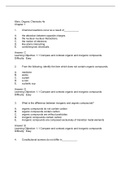
-
Test Bank for Organic Chemistry, 4th Edition by David R. Klein
- Exam (elaborations) • 2149 pages • 2022
-
- $49.99
- 74x sold
- + learn more
Test Bank for Organic Chemistry 4e 4th Edition by David R. Klein. ISBN-13: 9594 Full chapters test bank PDF TABLE OF CONTENTS 1 A Review of General Chemistry: Electrons, Bonds, and Molecular Properties 1 1.1 Introduction to Organic Chemistry 2 1.2 The Structural Theory of Matter 3 1.3 Electrons, Bonds, and Lewis Structures 4 1.4 Identifying Formal Charges 7 1.5 Induction and Polar Covalent Bonds 8 1.6 Reading Bond-Line Structures 11 1.7 Atomic Orbitals 14 1.8 Vale...
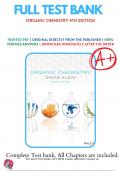
-
Test Bank for Organic Chemistry 4th Edition by David R. Klein | 9781119659594 |2021-2022 |Chapter 1-27 | All Chapters with Answers and Rationals
- Exam (elaborations) • 2151 pages • 2023
-
- $42.98
- + learn more
Test Bank for Organic Chemistry 4e 4th Edition by David R. Klein. ISBN-13: 9594 Full chapters test bank PDF TABLE OF CONTENTS 1 A Review of General Chemistry: Electrons, Bonds, and Molecular Properties 1 1.1 Introduction to Organic Chemistry 2 1.2 The Structural Theory of Matter 3 1.3 Electrons, Bonds, and Lewis Structures 4 1.4 Identifying Formal Charges 7 1.5 Induction and Polar Covalent Bonds 8 1.6 Reading Bond-Line Structures 11 1.7 Atomic Orbitals 14 1.8 Valence Bond Theory 17 1.9 Molecular...
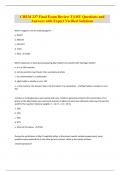
-
CHEM 237 Final Exam Review TAMU Questions and Answers with Expert Verified Solutions
- Exam (elaborations) • 29 pages • 2024
-
- $9.49
- + learn more
Which reagent is not an oxidizing agent? a. NaOCl b. KMnO4 c. K2Cr2O7 d. CrO3 e. H2O - H2O Which statement is false about preparing alkyl halide from alcohol with hydrogen halide? a. it is an SN1 reaction b. tertiary alcohols react faster than secondary alcohols c. the intermediate is a carbocation d. alkyl halide is soluble in conc. HCl e. in the reaction, the slowest step is the formation of a carbocation - alkyl halide is soluble in conc. HCl 2‐Chloro‐2‐methylpentane was tr...

How did he do that? By selling his study resources on Stuvia. Try it yourself! Discover all about earning on Stuvia


